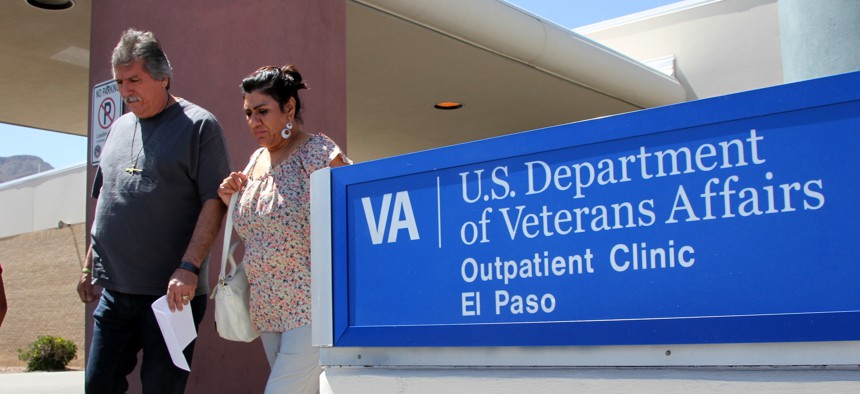
Patients exit the Vetarans Affairs facility in El Paso, Texas, June 9, 2014. Juan Carlos Llorca/AP
VA's Patchwork System Eats Most of its $4B Tech Budget. Congress Wants That to Stop.
The agency’s CIO says there’s no clear plan for replacing custom-built systems, two of which are more than 50 years old.
The 115th Congress hauled in leadership from the Veterans Affairs Department to discuss what’s become a very old problem for the agency tasked with taking care of those who served: information technology.
VA, with its history of failed large-scale IT projects that cost taxpayers billions of dollars, is again grappling with IT issues. This time, it isn’t a single program bleeding taxpayer dollars that is troubling Congress. Rather, it’s the agency’s aging IT systems, two of which are more than 50 years old, according to testimony from Dave Powner, director of IT management issues for the Government Accountability Office.
The age of some of VA’s oldest systems and its disproportionate spending on legacy technology clearly bothered several members of the House Committee on Veterans Affairs.
“It appears 86 percent of the money in IT is used for maintaining systems,” said Chairman Phil Roe, R-Tenn., who pressed VA Chief Information Officer Rob Thomas about what industry best practices for legacy spending were. Earlier, Powner had revealed that only about $400 million of the over $4 billion VA spends annually on IT is used to research and develop new systems.
“Our numbers are out of kilter from industry; we’d like to see 60 percent on maintenance and 40 percent on development,” Thomas said. “Right now, we’re turning at 85 to 90 percent sustainment, and we have to shrink that.”
Thomas told the committee VA stood up a modernization effort last year aiming to decommission old systems, close data centers and attempt to make a dent in the agency’s legacy spending. Thomas said that effort could help lead VA toward a buy-over-build approach to IT, which he himself supports.
Roe said the push for commercial-off-the-shelf solutions is encouraging, but tempered his enthusiasm. Congress has increased VA’s appropriations for IT an average of 7 percent over the past five years with little to show for it. While the Defense Department opted to go commercial for its electronic health records system two years ago, VA still grapples with whether to build its own system or follow DOD.
“My fear is that I’ve been sitting here eight years, listening to how it will get better, and I realize we have a lot of good, smart people working on this, and it’s obviously not easy,” Roe said. “But there are a lot of COTS products that can do scheduling and billing.”
Roe also voiced disgust at VA’s failed $5.3 million cloud migration contract.
“That money could have paid for so many other things,” Roe said. “Like 70 entry-level nurses in Johnson, Tennessee.”
VA’s consolidation of data centers is generally behind the rest of government. Despite being the fourth largest IT spender among all agencies, VA has closed only 20 of its 356 data centers, ranking 19th out of the 24 agencies GAO studied.
Powner said VA’s reported data center savings of $15 million since fiscal 2011 are pennies compared to the $2.8 billion other agencies saved collectively over the same period. VA also has yet to meet any metrics established by the Office of Management and Budget. To better keep tabs on progress at VA, Powner recommended the committee call VA personnel to Capitol Hill for quarterly updates. The committee agreed.
“We need to have clear transparency on what progress is being made, and when the goal posts change,” said Powner, referring to schedule slippages that are apt to occur in large software projects.
Thomas said VA has many large IT decisions to make in the near future, beginning as soon as President Donald Trump’s nominee for VA secretary, David Shulkin, is confirmed. Chief will be determining whether VA will transition to a commercial electronic health records system, though when pressed, Thomas said he had no idea how long it might take.
DOD is beginning pilots of its new EHR system, but its $9 billion contract was awarded almost two years ago. Acquisitions of that scale take time, and VA would be reluctant to cut corners given the scrutiny it is under.
Ranking member Tim Walz, D-Minn., said he wouldn’t suffer another decade of health records issues between VA and the Defense Department, and was disappointed to learn—from Powner—there still isn’t a seamless transition of health data for troops who transition to veterans. He called on Congress to demand interoperability between VA and DOD.
“I have to tell you, I cannot talk to a veteran and justify why we’re going to spend countless dollars for two systems that do not communicate and do not improve veterans’ experience,” Walz said. “We need to demand interoperability for one system and be responsible. Ten more years of it, I can’t stand it.”
If VA were to transition to a commercial EHR system, Thomas said the department would not necessarily have to use the same Leidos- and Cerner-developed system the Pentagon uses. Other commercial platforms should be interoperable, he said.
NEXT STORY: The US Does An About-Face on New Cyber Norms





